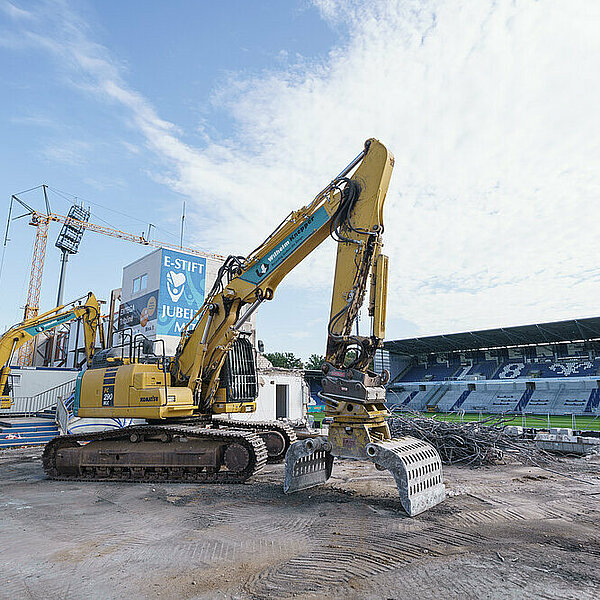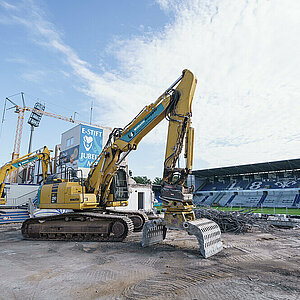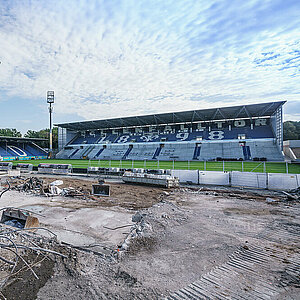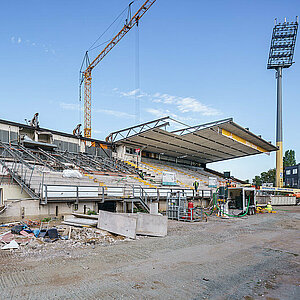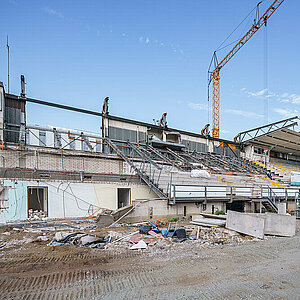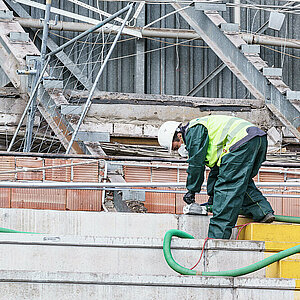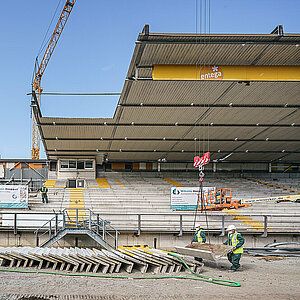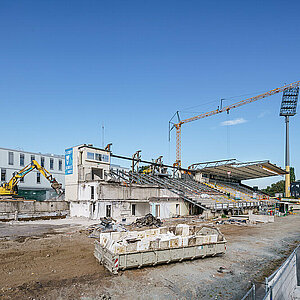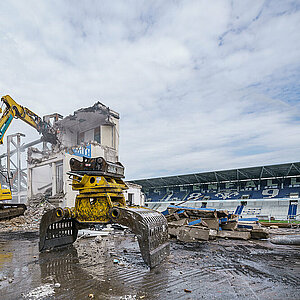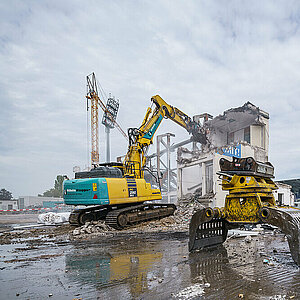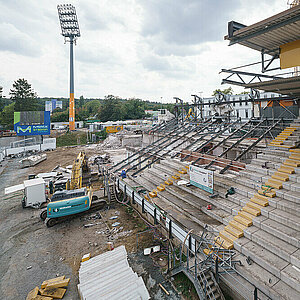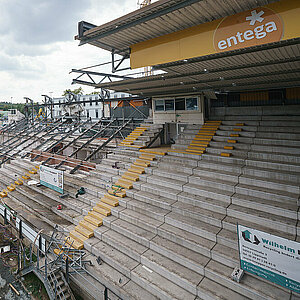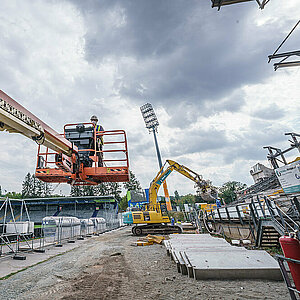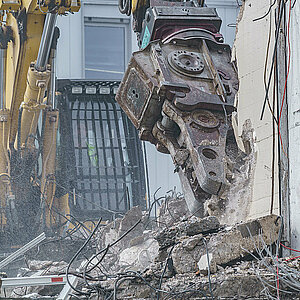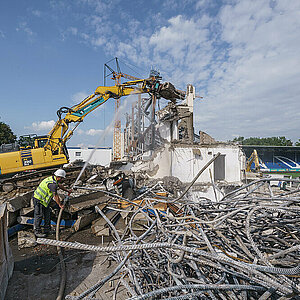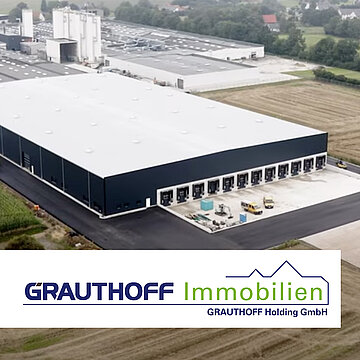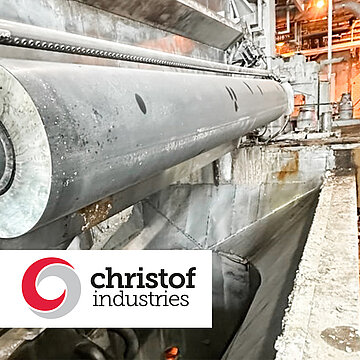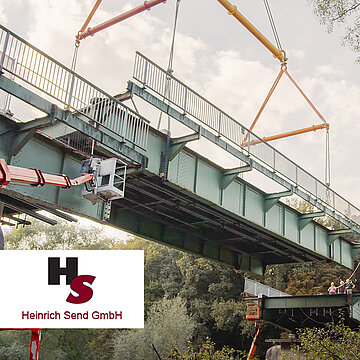
Demolition of the main stand of SV Darmstadt 98
The grandstand was precisely dismantled using specially adapted techniques and a high level of expertise. In doing so, it was possible to combine both economic and ecological goals in the best possible way.
Work carried out
- Building clearance
- Dismantling of asbestos-containing joint compound, ventilation/wastewater pipes and bituminous sheeting or barrier layers
- Dismantling of various insulation materials containing KMF
- Complete dismantling of the main stand including the foundations during ongoing training and match operations
- Exposure and dismantling of old foundations
- Creation of an earth subgrade for handover to the building construction company
Machines in use
- Tracked excavator up to 50 tons with OilQuick attachments
- Compactor
- Fast-erecting crane with approx. 30 m outreach
- BT-43 modules for milling asbestos-containing coatings, consisting of manual milling machine, high-performance vacuum cleaner, separator system and vacuum monitoring units
There was no alternative to demolishing the 1975 main stand at Böllenfalltor, where SV Darmstadt 98 fans cheered on their team for over 40 years. The ravages of time had taken such a toll on the traditional venue that it would have been uneconomical to renovate it. in 2016, the club management decided to carry out extensive modernization measures, including the construction of a new main stand. Before the new centerpiece of the stadium with 2,900 seats including 19 boxes and 9,000 business seats can be completed on the same site by 2022, the old main stand first had to be dismantled.
The operating company chose Wilhelm Knepper GmbH & Co. KG as its partner for this mammoth project, relying not only on a high volume of work, but also on a high level of problem-solving expertise. The dismantling of the main stand involved a special feature that required a great deal of experience in dealing with asbestos-containing building materials and technological know-how. At the time, the concrete grandstand steps were installed with an asbestos-containing bitumen adhesive, which adhered to the steps and had to be separated from the concrete beforehand for professional recycling. In order to achieve this with as few emissions and as economically as possible, demolition and refurbishment specialist Knepper modified the BT 43 milling process sold by ASUP GmbH for this project and used it successfully. "The trial remediation in the black area was absolutely convincing under the supervision of the Darmstadt Regional Council," explains site manager Pedro Cano-Martinez. "All test measurements showed that the asbestos fibers in the indoor air were well below the limit values, meaning that there was no need to set up airlocks and work areas with negative pressure." A win-win situation for everyone involved. This procedure meant that nobody came into contact with the hazardous waste, the set-up times were shorter and the costs for the negative pressure decontamination areas and the expensive outdoor measurements could be saved.
With the help of a crane, the grandstand was dismantled step by step and the asbestos-containing bitumen strip was milled off on both sides of each individual step. The self-extracting milling machine worked in a closed system with negative pressure, so that the asbestos-containing material was automatically fed into airtight big bags via hoses. Despite the extremely safe system, Sales Manager Stephan Dringenberg emphasizes: "Of course, the success of the process also requires a team that is well-versed in this technology. Knepper's remediation specialists are specially trained in the BT process and have experience from many other major projects in which the system has already been used.
The specialist for demolition, pollutant clean-up and industrial dismantling had calculated 12 weeks for the entire dismantling of the main stand, which was exactly adhered to. In the first step, Knepper began gutting the interior of the building on August 10, 2020. In addition to pollutants that had to be separated, such as old mineral fiber insulation and ventilation ducts made of asbestos cement, plasterboard, wood and other construction site waste were also completely removed. "We don't just do this because the Closed Substance Cycle Waste Management Act forces us to. The construction waste with its high concrete content is ideal for producing a very high-quality recycled gravel that can later be used for base courses, for example. Foreign materials do not belong in there. Ultimately, this makes sense from an ecological and economic point of view for everyone involved," explains Dringenberg.
At the same time, a crane was used to dismantle the grandstand roof. Special care was also required here, as polystyrene was used in the construction alongside trapezoidal sheeting and roofing felt. The prudent machine operators ensured that the polystyrene was not spread over the stadium turf and contaminated it when the roof panels were lifted off. After all, SV Darmstadt 98 had to be able to continue playing unhindered while the stands were being dismantled. Once the roof and the steps underneath had been removed, the final phase began. Now the heavy equipment from Knepper's own fleet of vehicles was used to remove the remains of the structure. In total, the demolition specialists processed around 4,000 tons of rubble. In the end, all that remained of the main stand was a sunken excavation pit - and a few tears from wistful fans.
Your contact person
SALES DEMOLITION AND DISMANTLING
Phone: +49 2941 2841-310
E-Mail: vertrieb@knepper-gruppe.de
Further references
